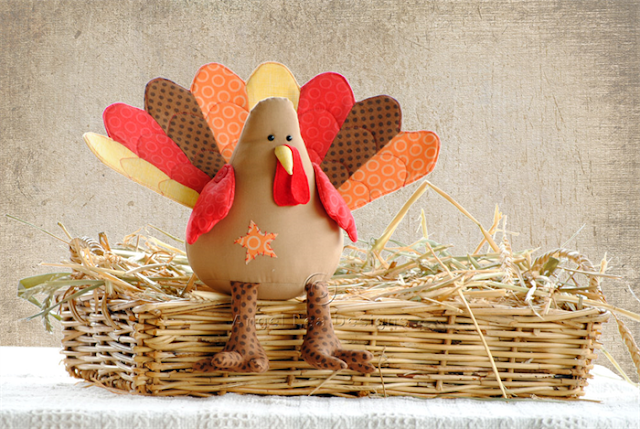Friday, October 23, 2015
Giving Thanks for Natural Stuffing
Nope. I'm not talking about turkey (or tofurkey) stuffing, although we all have our favorite recipes. I'm thinking more along the lines of a recipe for natural crafting goodness.
This year, I am grateful for the increasing accessibility to natural fiberfill toy stuffing. Want to know why? Because I'm tired of people who want to sell us something telling us it's completely safe when it isn't.
Why do people sell something? They want you to buy it. But WHY do they want you to buy it?
Natural stuffing choices, like cotton, kapok, and wool, were the norm until the 1960s when polyester fiberfill, a revolutionary, washable, lightweight fiber was made popular as a toy stuffing in mass-produced stuffed animals. Polyester fibers are made from oil-waste and by the 1960s, what to do with oil-waste was becoming a big problem. "Pollution" became a topic of motivation to reinvent this hazardous waste.
So makers of plastics want you to buy their products, because they don't want you to complain about that hazardous waste going into in your landfills, waterways, and air instead.
But polyester fiberfill is listed in the US Toxic Substances Control Act due to its toxicity when 1) it makes contact with soft tissue (eyes, lungs, stomach) and 2) when it produces highly toxic fumes when it burns.
Polyester fiberfill manufacture requires the use of half a dozen known highly toxic, carcinogenic, and polluting chemicals including dichloroethane. The making of these fibers, even the recycling of them, can never be considered eco-friendly given the amount of toxic pollution it causes to air and groundwater. According to this toxicology report by the CDC (Center for Disease Control), dichloroethane has been found in peanut butter due to manufacturing run-off into local groundwater near peanut farms.
If you aren't quite familiar with what polyester fiber really is, read this fascinating article describing the formation of polymers and specifically polyester and why it is more toxic than we have been led to believe.
Thank goodness nature is still providing plant and animal fibers for use in crafting, sewing, quilting, and toy-making. If you haven't played with warming wool fleece, bouncy non-GMO corn stuffing, or luxurious kapok, you're missing out on a world of sensory delights.
Ready to buy a natural fiberfill? Here's my latest list of sources for natural fiberfill and also fabrics.
And if you want to know more about the toy stuffing performance of various types of natural fill, read this.
To-do: If you have any favorite natural fiber or fabric sources where you live, please share them in them in the comments or email me so I can include them in the list.
PS: Click on the turkey photo for a link to the pattern by Angel Lea Designs.
Wednesday, October 7, 2015
Darned Embroidery
I was stoked to have a pattern darning sampler embroidery tutorial published on the Sew Mama Sew blog a couple of weeks ago. Pattern darning is a simple running stitch that creates a design over counted threads.
Since the post came out, people have been asking me for easy to read patterns. I thought, no problem, I'll just google pattern darning and refer stitchers to the many designs online. Unfortunately I found the patterns a bit hard to read.
Online pattern darning patterns are usually on a graph or grid. But when the patterns are presented in the same way as cross-stitch patterns, with blocks filled in, I find that the maker sometimes means take my running stitch over one thread (represented by the block) or over two threads (represented by the lines of the grid on each side of the block). It's not consistent and the cross-stitch pattern illustration method does not fit pattern darning designs.
The best ones I've found show stitching between threads and over and under threads, where it actually occurs.
Since these are far and few between, I decided to start drawing up these designs on graph paper in the same style as this image which is from the American Needlepoint Guild.
I'm so excited by my fresh new pad of graph paper, I can hardly contain myself. I have managed to list one pattern of eight designs in my Etsy shop.
Imagine your clothes magically transformed by small borders of pattern darning. Turn linens into vintage era keepsakes with simple running stitches. Pattern darning has a long and rich history of transforming ordinary textiles into works of art and imagination.
Visit the Sew Mama Sew sewing blog for tons of sewing and stitching tutorials, challenges, and to meet fascinating fiber artists and designers from all over the world. There's a project for every type of sewing, from clothing to softies to quilts to mobiles. And try out a bit of pattern darning while you're there.
Since the post came out, people have been asking me for easy to read patterns. I thought, no problem, I'll just google pattern darning and refer stitchers to the many designs online. Unfortunately I found the patterns a bit hard to read.
Since these are far and few between, I decided to start drawing up these designs on graph paper in the same style as this image which is from the American Needlepoint Guild.
I'm so excited by my fresh new pad of graph paper, I can hardly contain myself. I have managed to list one pattern of eight designs in my Etsy shop.
You don't need much to create beautiful stitching: fabric, embroidery floss or darning wool, blunt darning or tapestry needle, scissors, and a pattern.
Visit the Sew Mama Sew sewing blog for tons of sewing and stitching tutorials, challenges, and to meet fascinating fiber artists and designers from all over the world. There's a project for every type of sewing, from clothing to softies to quilts to mobiles. And try out a bit of pattern darning while you're there.
Subscribe to:
Posts (Atom)







